The 2022 Winners of the Lifetime Achievement and Emerging Leader in Chromatography Awards
Barry L. Karger and James P. Grinias are the winners of the 15th annual LCGC Lifetime Achievement and Emerging Leader in Chromatography Awards, respectively. Here, we review their achievements.
Barry L. Karger and James P. Grinias are the winners of the 15th annual LCGC Lifetime Achievement and Emerging Leader in Chromatography Awards, respectively. The LCGC Awards honor the work of leading separation scientists for lifetime achievement and emerging potential (Table I). This year, given the cancellation of the live Pittcon conference, Karger and Grinias will be recognized during a special online Pittcon session.

The Lifetime Achievement in Chromatography Award
The 2022 Lifetime Achievement in Chromatography Award honors an outstanding and seasoned professional for a lifetime of contributions to the advancement of chromatographic techniques and applications.
Barry L. Karger, the 2022 winner, is the Director Emeritus of the Barnett Institute for Chemical and Biological Analysis, and the James L. Waters Emeritus Chair and Distinguished Professor Emeritus at Northeastern University in Boston. Over the 60-year span of his career, Karger made major advances in the understanding of fundamentals of chromatography and capillary electrophoresis (CE) techniques and to their application, particularly in the fields of protein and DNA analysis. With an h-index of 98, Karger has left a major impact in the field of separation science.
Barry L. Karger
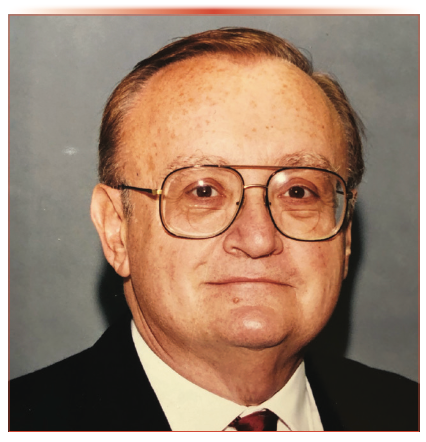
Karger founded the Barnett Institute of Chemical and Biological Analysis in 1973. Over the years, the institute has been a major contributor in developing analytical methods for the biological sciences and the instrumentation and biotechnology industries. Barnett has produced over 500 PhDs, postdocs, and staff, many of whom have gone on to have distinguished careers in academia and in the industry.
Main Research Fields
The broad range of the fundamentals and technologies associated with separation and biological sciences for Karger include:
- Gas chromatography (GC)
- Selectivity and efficiency of high performance liquid chromatography (HPLC) and CE fields
- LC separation and analysis of peptides and proteins
- Hydrophobic interaction chromatography (HIC)
- Separation of protein species on small particle columns
- Separation of oligonucleotides by CE
- Automated long read DNA sequencing, the Human Genome Project
- Narrow bore LC columns for sensitive LC–MS proteomics
- Characterization of protein biopharmaceuticals by LC– and CE–MS.
Major Contributions
Given the breadth and depth of Karger’s work, his impact has been significant, both in terms of the fundamentals of separation techniques and their applications.
Developing Fundamental Principles of Separations
From the beginning of modern-day chromatography in the 1960s, Karger and colleagues were involved in developing the fundamental principles of separations (1,2). He began his research career in GC, where he introduced time normalization for column comparison. He was also active in diastereoisomer separation with GC, which has become a basis for chiral separation.
With the introduction of HPLC in the late 1960s, Karger became an early leader in this then-new technique. Along with Csaba Horváth, Karger was one of the first to develop reversed-phase LC (RPLC), now the predominant LC mode. His development of sensitive methods to evaluate bonded phases led to improved RPLC method reproducibility and overall performance. In collaboration with Lloyd Snyder, he introduced a means of classifying mobile phases in RPLC, which led to a better understanding of selectivity. By using chiral chelate additives, he was the first to show direct enantiomeric separations using LC.
“His contributions to the understanding and optimization of the principles of HPLC laid a foundation on which the practice has been built,” said Charles L. Cooney, the Robert T. Haslam Professor Chemical Engineering Emeritus at the Massachusetts Institute of Technology (MIT). Cooney is a major figure in biotechnology, especially bioprocess engineering.
Karger’s influence on the fundamentals of separations extends well beyond RPLC.
“One of his greatest contributions was shedding light on the basic principles of hydrophobic interaction chromatography (HIC),” said former postdoc, Andras Guttman, the MTA-Lendület Professor of Translational Glycomics at the University of Pannonia and Debrecen, in Hungary.
Karger is also well-known for his work on CE. “His most important contribution to the field of capillary electrophoresis was pioneering the method in the early days, even initiating a conference series dedicated to it,” said Guttman. In 1989, Karger started the first conference series on the technique, called High Performance Capillary Electrophoresis (HPCE); the event is still organized yearly under the name of Microscale Bioseparations (the 37th meeting was held online last July). “Without his contribution, the CE field would not be at this level today,” said Guttman.
“Barry helped put high performance capillary electrophoresis (HPCE) on the map,” noted Peter Schoenmakers, a professor of analytical chemistry at the University of Amsterdam. “HPCE was invented by Jim Jorgenson, but it needed a bigger following for it to grow. Karger’s influence and scientific contributions, as well as his talents as an organizer and driving force, were of great importance for HPLC and HPCE. Karger was also a member of the Permanent Scientific Committee of the HPLC series for over 25 years.
A Fundamental Textbook
In 1973, with Snyder and Horvath, Karger co-authored and edited the textbook, An Introduction to Separation Science (3). This important book, which has 804 citations according to Google Scholar, was used to train over two generations of analytical chemists in chromatographic fundamentals.
“Although out-of-print, An Introduction to Separation Science was the leading textbook on chromatographic methods,” says Howard Barth, a consultant who is retired from the DuPont Company, and who was a student of Karger’s for both his undergraduate and PhD studies. “For many years, it remained my ‘go-to book’ to check an equation or clarify a concept.”
Applying Separations to Real-World Problems
The fundamental developments that Karger advanced were also significant in the adopting techniques for practical applications.
“Prof. Karger was instrumental in establishing HPLC as the method of choice for the separation and detection of compounds,” Barth said. “Barry was involved in applying separation science to emerging fields, such as forensic science, clinical chemistry, and bioanalysis.”
Jonathan Bones, a principal investigator at the National Institute for Bioprocessing Research and Training (NIBRT) in Dublin, Ireland, agrees. “What’s so impressive when you look back at Barry’s career is his ability to transition from one application area to another, realizing the potential to translate his skills and excellence in separation science to deliver real impact in an emerging application area,” he said.
A photo from the 4th International HPLC meeting in Boston in 1979. Karger was the chairman of the meeting. The people in the photo are (left to right): Faith Waters, Sefa Huber, Jack Kirkland, Karger, Trudy Karger, and Josef Huber. Behind Trudy Karger is Jim Waters and behind Mrs. Waters is Peter Schoenmakers. Kirkland, Huber, and Waters are first generation giants in the LC field.
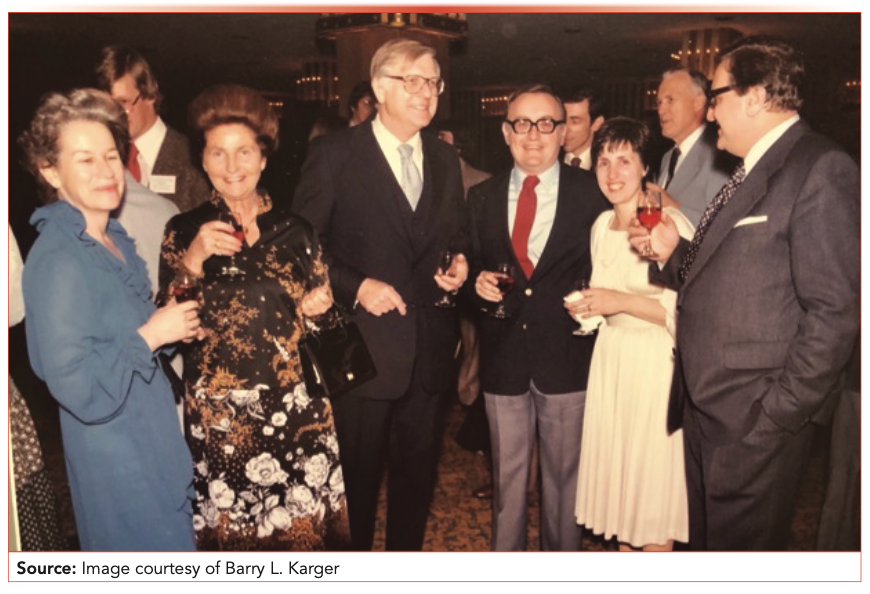
The Human Genome Project
The greatest societal impact of Karger’s work came from his development of CE in the 1990s for DNA sequencing for the Human Genome Project (4). Karger and coworkers showed that it was possible to obtain high performance sequencing from run-to-run simply by blowing the linear polymer separation matrix out of the capillary and reloading it with a fresh matrix. This discovery opened the door for automated sequencing analysis. Karger’s group was first to achieve a read length of 1000 bases and was able to obtain 1300 bases with a column efficiency greater than 10,000,000 theoretical plates (5). Karger’s linear polymer matrix was used to sequence 40–50% of the first human genome.
Protein Separations and Biopharmaceutical Analysis
Of all the application areas where Karger worked, a major one is protein analysis. Early on, as biology developed into a molecular science, and when biotechnology cell culture and fermentation studies began, Karger started to explore protein separation using RPLC (6). By the mid-1980s, Karger’s work had shifted from small molecules to focus on the analysis of peptides and proteins, especially the native-denatured behavior of proteins in RPLC.
“We explained multiple peaks observed for seemingly pure proteins as due to partial denaturation when associated with the reversed-phase surface,” Karger said. “We also explored peak broadening due to reversible conformational changes of proteins in the mobile phase.”
“Barry’s most significant contributions to chromatography, although I should rather say to separation science, is his sightedness in seeing the huge opportunities that integration of advanced separation methodologies and analytical sciences can offer biosciences,” said Wolfgang Lindner, an emeritus professor at the University of Vienna and former Karger post-doc. “A key message Barry spread is to understand the background of the analytical question and thus to apply the most appropriate application of analytical methodology to generate valuable information buried in complex biological samples.”
“Barry was driving the analytical (and especially the HPLC) community to embrace the life science fields (genomics and proteomics) that were experiencing dramatic advances,” Schoenmakers says. “It greatly enhanced the relevance of HPLC.”
Karger and his team introduced HIC for protein separations using a small-particle column format to separate proteins while main- taining the proteins in a bioactive state (7).
LC–MS and CE–MS in Protein Analysis
In the early 2000s, Karger’s focus shifted to the coupling of mass spectrometry (MS) with LC and CE for protein analysis and proteomics (8). He emphasized the importance of low flow rates for achieving high sensitivity in electrospray ionization (ESI)–MS. He devoted significant effort into developing narrow-bore LC columns for online MS coupling, first with 15-μm i.d. monoliths, achieving attomole level detection (9), and then introducing 10-μm i.d. porous-layer open tubular (PLOT) columns for even higher sensitivity (zeptomole) with high efficiency (10). This work facilitated the analysis of low-volume clinical samples and led to the identification of important cancer and blood biomarkers (11).
His LC–MS and CE–MS research also expanded to include detailed characterization of protein biopharmaceuticals. Using LC–MS, his group was able to elucidate the disulfide linkages in a protein with a complicated cysteine knot where a total of 15 possibilities existed. In another example, his group characterized beta-interferon using CE–MS. Achieving over 400,000 theoretical plates, a total of 138 different modifications were found in the analysis of the intact protein. These analytical techniques are extremely powerful and in routine analytical use today in the biopharmaceutical field.
Influence on Biopharmaceutical Industry—From its Infancy to Today
All the biopharmaceutical analysis work by Karger and his group did not just have academic interest; it was applied to solve the real-world problems of the biopharmaceutical industry, right from the industry’s beginnings.
When Robert Garnick, a Barnett Institute alumnus, joined the then fledgling start-up company Genentech in 1984, he was responsible for developing and characterizing many of the earliest biotechnology products. Karger, who was a consultant to Genentech, worked closely with Garnick and the analytical chemists there in applying HPLC, CE, and bioassays to the characterization and structural elucidation of these complex proteins. “Dr. Karger’s influence was fundamental in developing the scientific regulatory strategies used to obtain global approval for these products,” says Garnick, who is now the president and CEO of Lone Mountain Biotechnology.
That type of collaboration with biopharmaceutical scientists continues today. Jonathan Bones first met Karger in 2008, when Bones was a postdoctoral researcher under Professor Pauline Rudd at NIBRT. After Rudd met Karger at the HPLC 2008 conference, Karger visited NIBRT in Dublin. Among the topics, he discussed his recent work developing hydrophilic-interaction chromatography (HILIC) functionalized columns for glycan analysis. Bones was initially sent to Karger’s laboratory at Northeastern to learn the system. Later, he spent two years with Karger as a John Hatsopolous Fellow focusing on LC–MS applied to biotechnology problems.
“The time I spent with Prof. Karger at the Barnett Institute was excellent,” he said. “The quality of research performed within the group combined with the caliber of collaborators from the clinical and biotech communities that creates the buzz about Boston was exciting and motivating,” he said. “His passion and enthusiasm for research, his depth of knowledge and his energy are incredibly admirable, to the point of envy.” Karger and Bones still collaborate through NIBRT applying analytical methods on current biotechnology problems using state-of-the-art instrumentation.
Karger in 1985 receiving the James L. Waters Chair of Analytical Chemistry by the late NU president Kenneth Ryder (center) and the late James L. Waters, founder of Waters Associates.
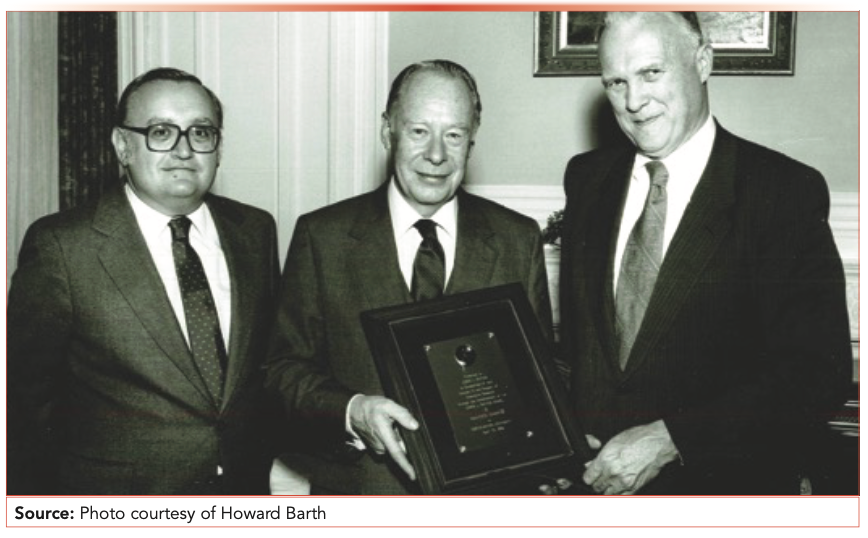
This photo was taken at the 39th International HPLC in Amsterdam in 2013. From left to right: Peter Schoenmakers, Karger, Wolfgang Lindner, and Nobuo Tanaka. These three distinguished chromatographers worked in Karger’s laboratory.
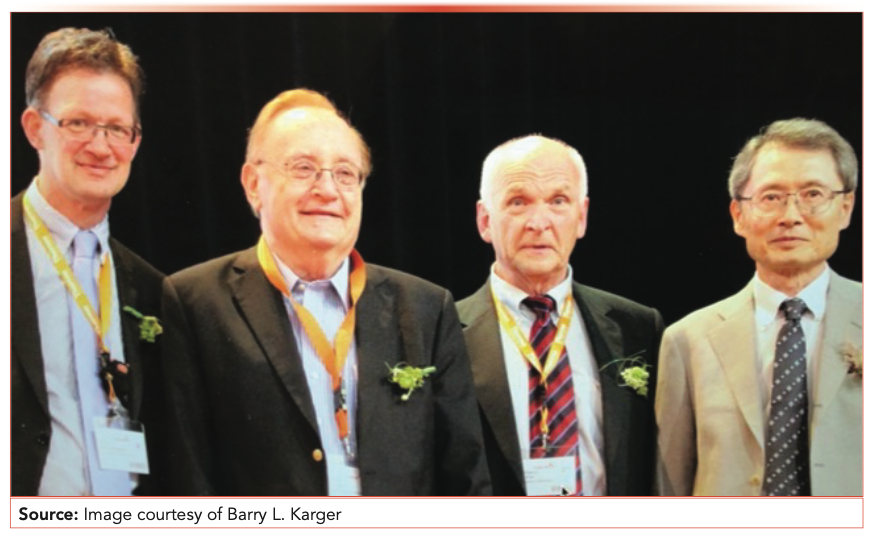
Teacher, Mentor, and Leader
Karger’s long, productive, and distinguished career has produced excellent and impactful output not only in the form of publications but also in the form of hundreds of highly skilled scientists, who themselves have gone on to have their own outstanding careers. Indeed, many of Karger’s students and post-doctoral researchers have had distinguished careers in both academia and industry.
“He is an outstanding educator, and his students and postdocs populate the who’s who of separation science,” said Cooney.
Schoenmakers echoed that point. “Barry has contributed to the scientific development of many of the people who became leaders in the separations and analytical fields, including the likes of Wolfgang Lindner, Nobuo Tanaka, Heinz Engelhardt, Frantisek Foret, Howard Barth, and many, many more, including myself,” he said. “He has very impressive intellectual offspring.” Moreover, Professor Karger has trained many outstanding scientists who have had a significant impact in the instrumentation and biotechnology industries.
“I am most proud of the many PhD students, post docs and staff who worked in my lab,” Karger said.
That pride showed in his dedication to his students. “Even with a large group of graduate students and postdocs, he would devote weekends with us getting manuscripts into shape for publication, pondering over data, and helping us plan future research,” said Barth. “He never micromanaged; instead, he encouraged us to explore new leads and ideas.”
Karger’s mentorship went beyond his students, to the many whom he guided and supported in the biopharmaceutical industry in particular—both through personal support as well as scientific and technological development.
“Barry has been very helpful to me and assisting with my own career development,” said Bones. “I know I’m one of many over the years that Barry has picked up the phone to call and given his time to—and for that Barry, a very sincere thank you.”
“Dr. Karger is unique in his dedication to his students and friends,” said Garnick. “He has always been there for us and his enthusiasm for analytical chemistry is contagious.”
“In Karger’s laboratory, there was a lot of creativity and a lot of teamwork, and many close friendships and collaborations were forged,” said Schoenmakers. “Barry was creating the kind of atmosphere that hip companies from the United States West Coast are now known for.”
“He stands as a shining image of the best in science as well as his dedication to all those he has touched throughout his career,” echoed Garnick.
A cartoon depicting the contrasting humor and gravitas of Karger’s laboratory environs drawn by former Karger post doc Kalman “Berci” Benedek in the early 1980s.
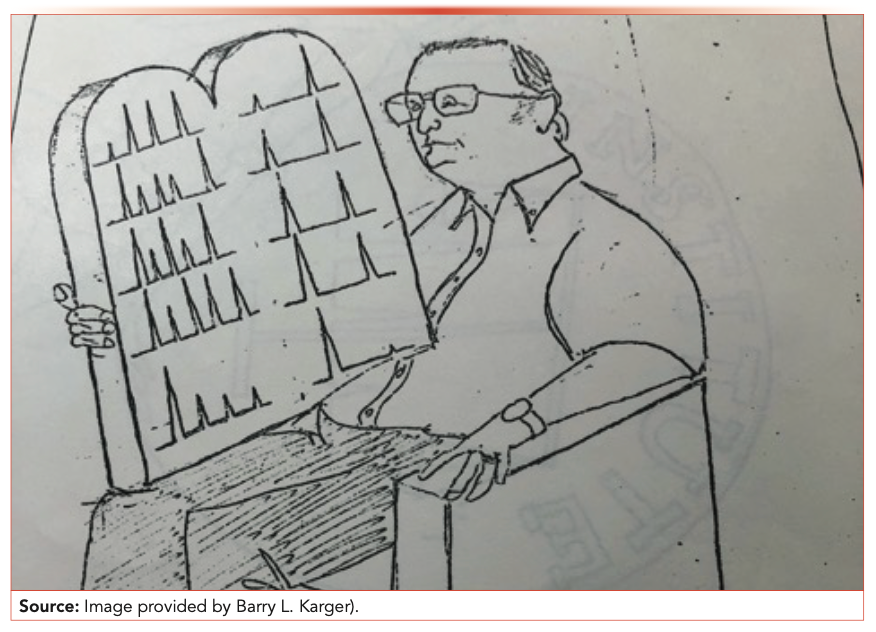
Numerous Awards
Given his accomplishments, it is not surprising that Karger has received numerous awards and honors over his career. Highlights include the Steven dal Nogare Memorial Award for Chromatography (1975), the American Chemical Society (ACS) Award in Chromatography (1982), the M.S. Tswett Medal in Chromatography (1986), the ACS Award in Analytical Chemistry (1990), the A.J.P. Martin Medal (1991), the EAS Symposium Award for Outstanding Achievements in the Field of Separations Science (1997), the ACS Award in Separations Science and Technology (1998), and the Halász Medal of the Hungarian Chemical Society for Chromatography and Separation Science (2002). He has also received the CaSSS Award (2003), the Michael Widmer Award (2004, Switzerland), the Torbern Bergman Medal (2008, Sweden), the Csaba Horváth Medal (2008), the Golay Medal, (2009), the Csaba Horváth Lectureship (2010, Hungary), the J. Heyrovsky Honorary Medal (2010, Czech Republic), and the Arnold O. Beckman Medal (2014).
A portrait of Professor Karger made by Kalman “Berci” Benedek in the early 1980s. “Barry liked the portrait so much that it was framed and kept in his office.”
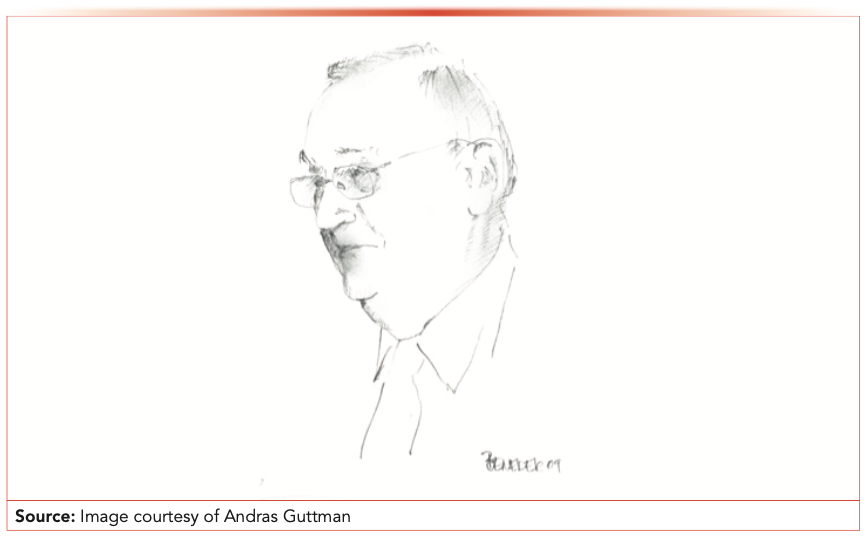
An Important Legacy
Clearly, Barry Karger’s legacy on the field of separation science is significant.
“Barry is part of the first generation of analytical chemists who introduced the world to a revolutionary separation technique, HPLC, that continues to grow,” Howard Barth said. “Through his research, teaching, and publications, he has continued on this path of scholarship well past becoming an emeritus professor.”
And even once Barry Karger does fully step away from his work, his legacy will live on through his patents, his publications, and the impact he made on his students and colleagues, and the Barnett Institute that he founded at Northeastern University will continue to advance the field. "He created an organization that has become the preter for high resolution characterization of biologics,” said Cooney.
“Barry really is one of the fathers of modern chromatography,” said Bones.
Guttman agrees. “It is clear that his impact over the 50-plus years of his career has been profound,” he said. “He is one of the most well-known and respected chromatographers of his generation.”
Most Recent Publications
The most recent key papers involving Karger, published since 2018 and later, explore multi-omics analysis to investigate high-resolution bioseparations for therapeutic protein analysis. This basic research has focused on answering questions related to the effect of bioprocess conditions on product titer and expressed drug substances for different production cell lines. These papers reflect the remarkable fact that Karger is staying current and is one of the last remaining active scientists in chromatography from the early 1960s and 1970s.
Most recently in collaboration with Andras Guttman, Karger has studied the fundamentals of sodium dodecyl sulfate capillary gel electrophoresis (SDS-CGE) coupled to MS. In this work, multiple gel formulations of borate cross-linker and dextran monomer were evaluated to optimize therapeutic protein analysis (12). The gel structure changes with composition was elucidated by examining solute sieving behavior. Further, glycan interaction with the dextran monomer was shown to influence migration time.
Karger has researched the impact of various process parameters on the productivity and product quality of monoclonal antibodies (mAbs) produced by Chinese hamster ovary (CHO) cell lines (13). This basic research focuses on how certain process parameters might affect cellular mechanisms in different production cell lines in terms of product titer and the specifics of expressed drug substances.
A study by Karger and colleagues performed multi-omics analysis to investigate the concentration of the amino acid cysteine (Cys) to cellular response of a Chinese hamster ovary (CHO) cell line for production of a mAb product (14). This work led to the discovery that when Cys feed levels are not high enough there is a significant decrease in protein titer.
Biopharmaceutical production processes, involving therapeutic protein production may be improved by careful control of cellular nutrition and growth conditions. Karger and coworkers have also performed a lipidomics analysis for the first time, in 5-L bioreactors, over the time course of CHO cells producing an IgG1 mAb (15). This research explored the use of LC–MS identification and quantitation of 377 unique lipids in the CHO lipidome.
Acknowledgments
To Professor Andras Guttman, PhD, DSc, and Howard Barth, PhD, for their contributions to the detailed historical information on Professor Karger’s career.
References
(1) B.L. Karger, in Modern Practice of Liquid Chromatography, J.J. Kirkland, Ed. (John Wiley & Sons, Inc., New York, NY, 1971).
(2) B.L. Karger, M. Martin, and G. Guiochon, Anal. Chem. 46(12), 1640–1647 (1974).
(3) B.L. Karger, L.R. Snyder, and C. Horvath, An Introduction to Separation Science (Wiley-Interscience, New York, NY, 1973).
(4) M.C. Ruiz-Martinez, J. Berka, A. Belenkii, F. Foret, A.W. Miller, and B.L. Karger, Anal. Chem. 65(20), 2851–2858 (1993).
(5) H. Zhou, A.W. Miller, Z. Sosic, A.E. Barron, B. Buchholz, L. Kotler, and B.L. Karger, Anal. Chem. 72(5), 1045–1052 (2000).
(6) S.A. Cohen, K.P. Benedek, S. Dong, Y. Tapuhi, and B.L. Karger, Anal. Chem. 56(2), 217–221 (1984).
(7) S.A. Cohen, K. Benedek, Y. Tapuhi, J.C. Ford, and B.L. Karger, Anal. Biochem. 144(1), 275–284 (1985).
(8) S.-L. Wu, A. Huhmer, Z.-Q. Hao, and B.L. Karger, J. Proteome Res. 6(11), 4230–4244 (2007).
(9) A. Ivanov, L. Zang, and B.L. Karger, Anal. Chem. 75(20), 5306–5316 (2003).
(10) G. Yue, Q. Luo, J. Zhang, S.L. Wu, and B.L. Karger, Anal. Chem. 79(3), 938–946 (2007).
(11) M. Guergova-Kuras, I. Kurucz, W. Hempel, N. Tardieu, J. Kádas, C. Malderez-Bloes, et al., Mol. Cell Proteomics 10(12), M111.010298 (2011).
(12) A. Guttman, C. Filep, and B.L. Karger, Anal. Chem. 93(26), 9267–9276 (2021).
(13) L. Strasser, A. Farrell, J.T. Ho, K. Scheffler, K. Cook, P. Pankert, et al., Front. Bioeng. Biotechnol. 9, 270 (2021).
(14) A.S. Ali, R. Raju, R. Kshirsagar, A.R. Ivanov, A. Gilbert, L. Zang, and B.L. Karger, Biotechnol. J. 14(4), 1800352 (2019).
(15) A.S. Ali, R. Raju, S. Ray, R. Kshirsagar, A. Gilbert, L. Zang, and B.L. Karger, Biotechnol. J. 13(10), 1700745 (2018).
The Emerging Leader Award
The Emerging Leader in Chromatography Award recognizes the achievements and aspirations of a talented young separation scientist who has made strides early in his or her career toward the advancement of chro- matographic techniques and applications.
James P. Grinias, the 2022 winner, is an associate professor in the Department of Chemistry and Biochemistry at Rowan University. His research focuses on advancing ultrahigh-pressure liquid chromatography (UHPLC), supercritical fluid chromatography (SFC), reversed-phase LC (RPLC), high-throughput LC, portable chromatography instruments, and multidimensional liquid chromatography (MDLC) instrumentation and workflows.
James P. Grinias
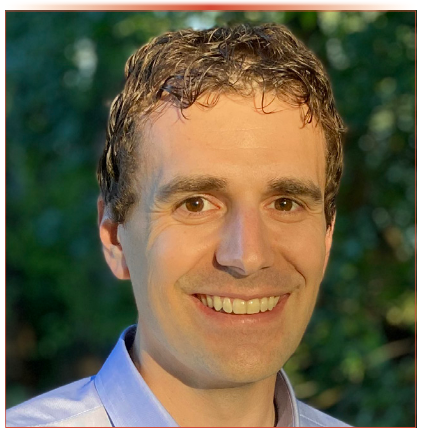
Grinias received a PhD in analytical chemistry from the University of North Carolina (UNC)-Chapel Hill in 2014 with a dissertation titled, “Characterization and Control of Band Broadening in UHPLC Columns,” with advisor Jim Jorgenson. He received his BS in chemistry from Eastern Michigan University in 2009.
Capillary LC for Clinical and Pharmaceutical Analysis
Since receiving his PhD, Grinias has worked for the past eight years to improve chemical separation techniques for the analysis of biological and pharmaceutical molecules. He has applied his research efforts toward solving multidisciplinary problems using microfluidics and chromatography, with a focus on capillary LC for food and beverage applications, clinical samples, and pharmaceutical products.
Grinias is currently working on projects that are providing analytical solutions to the biological, clinical, and forensic markets. His work on portable LC involves the easy and effective screening of illicit drugs from urine in clinical settings and online reaction monitoring in the pharmaceutical industry. For metabolic studies, the coupling of ion exchange chromatography (IEC) and SFC is being investigated for the separation and detection of derivatized organic acids. He is further expanding this work into the area of two-dimension (2D)-LC with studies focused on parallel arrays of capillary LC columns in the second dimension.
As an associate professor at Rowan University, Grinias has conducted research with both undergraduate and graduate students. With his research group at Rowan, Grinias has published 22 papers on the subjects of instrument design and miniaturization, superficially porous particles (SPPs), and fast LC. Grinias has published 32 papers with 607 citations on Google Scholar, and an h-index of 12 and an i10 index of 14. He has also presented more than 80 oral and poster presentations at scientific conferences.
He serves on the organizing committees for the HPLC and ISCC symposia series when the meetings are held in the United States. He has served as the program chair and president of the Chromatography Forum of Delaware Valley (CFDV), and as secretary and chair-elect of the American Chemical Society (ACS) Subdivision of Chromatography and Separations Chemistry. He is also a reviewer for and a member of the editorial advisory boards of several analytical chemistry journals.
His scholarships and awards include the American Chemical Society (ACS) Satinder Ahuja Young Investigator in Separation Science Award (2021), the National Science Foundation (NSF) Career Award (2021), the Chinese American Chromatography Association Young Investigator Award (2020), Eastern Michigan University Outstanding Young Alumnus Award (2017), an NIH NRSA Postdoctoral Fellowship (2015), Shimadzu ISCC Best Poster Award (2014), HPLC Csaba Horváth Top Young Scientist Award (2013), an NSF Graduate Research Fellowship (2010), and other awards.
Key Recent Publications
The most recent key papers by Grinias, published since 2015 and later, present recent research in UHPLC, MDLC, segmented flow droplet microfluidics, SFC, and portable capillary LC.
Recent advances in UHPLC and MDLC are described in a 2021 published review by Grinias and coworkers (16). Topics covered include column technology and system design, a novel injector concept, newer detector technology, and instrument diagnostic approaches. Online MDLC workflows and advances in modulation technology are also reviewed, along with notable applications published during 2020.
In a paper on a low-cost flow approach for segmented flow droplet microfluidics, Grinias and colleagues compared an open-source peristaltic pump primarily composed of three-dimensional (3D)-printed parts with a low-cost commercial Venturi pump (17). This study compared an open-source peristaltic pump primarily comprised of 3D printed parts with a low-cost commercial Venturi pump. These are explored as alternatives to syringe pumps for droplet microfluidics. Both devices provided stable flow, with <2% relative standard deviation (RSD), over a range of 1–7 μL/min and high reproducibility in signal intensity at a droplet generation rate at approximately 0.25 Hz (<3% RSD)—which is comparable in performance to similar measurements on standard syringe pumps. A miniaturized Venturi pump was also applied to droplet signal monitoring to measure changes in concentra- tion over time, demonstrating an average signal reproducibility of <4% RSD for single-stream fluorometric and reagent addition colorimetric applications.
Grinias and Franklin have explored the various sample injection aspects of ultrafast LC, useful for high-throughput LC (18). The authors investigated the current status of injector systems and auto sampling technology to include strategies for reducing injection cycle times, and suggestions for future development concepts.
A review published by Grinias and colleagues focused on the advantages of two-dimensional separation techniques using SFC (19). They noted that SFC is useful in multidimensional separations given its characteristic high solvent compatibility, rapid duty cycles, and orthogonality to other separation modes. The review described valving schemes and modulation strategies used for interfacing SFC to LC and GC techniques. The analysis of oils and chiral separations of pharmaceutical compounds are emphasized using multidimensional separations with SFC.
Augmented reality technology can be used for instruction and teaching of analytical instrumentation design as an addition to an undergraduate-level chemistry curriculum (20). Grinias and coauthors used an augmented reality platform to build digital overlays activated by viewing an analytical instrument through a smartphone camera. These overlays show further information on the instrument components and operation. Current created overlays are for a double-beam UV-vis spectrophotometer, flame atomic absorption spectrometer, liquid chromatograph, and gas chromatograph–mass spectrometer.
Three UNC graduates James Grinias, William Black, and Edward Franklin (left to right) reunite in June 2015 at the HPLC Conference in Geneva, Switzerland.
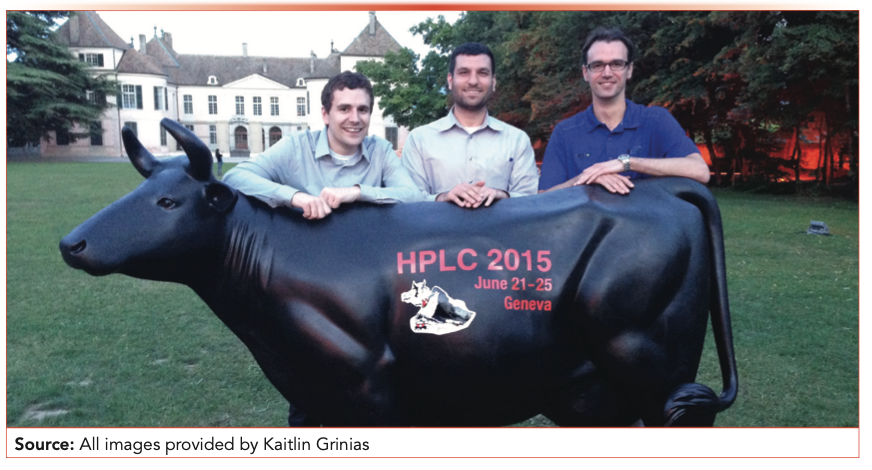
Grinias and coworkers studied the unexpectedly large contributions of the injector and connecting tubing to extracolumn band broadening in a capillary LC system (21). The Taylor-Aris theory was applied along with the Foley-Dorsey exponentially modified Gaussian peak fitting model to characterize chromatographic peaks for this study. It was determined that excessive peak broadening was caused by the tau-type contributions resulting from poorly-swept volumes at the injector and tubing connections. This paper gives a strategy for reducing peak tailing and tau-type contributions.
Five former Jorgenson group members Justin Godinho, Edward Franklin, James Grinias, Kaitlin Grinias, and Laura Blue (left to right) are about to enjoy a French dinner in June 2016 at the HPLC Conference in San Francisco, United States. James Grinias was the head volunteer at this conference chaired by his post-doctoral advisor, Robert Kennedy. Thank you to Lois Beaver for hosting the dinner for all conferee volunteers.
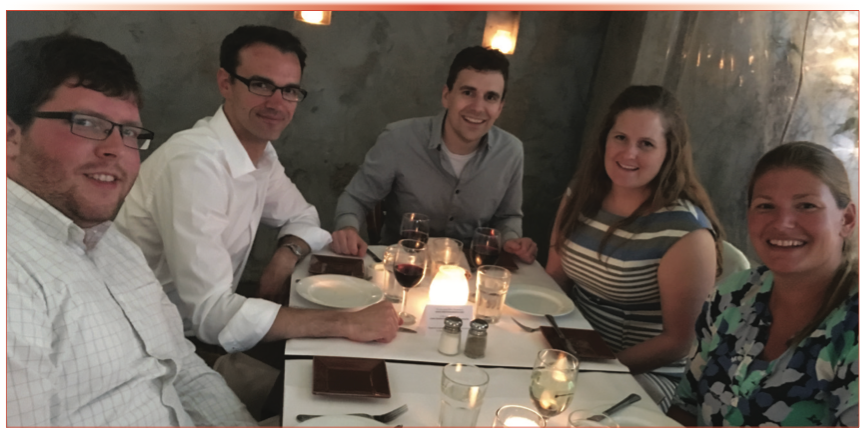
A new portable capillary liquid chromatograph designed for potential use by law enforcement to measure pharmaceutical and illicit drug compounds was investigated by Grinias and collaborators at Axcend (22). The chromatograph was evaluated using several over-the-counter analgesic drug substances and was also tested to perform online tablet dissolution measurements. The chromatograph, consisting of two high-pressure syringe pumps capable of flow rates at pressures of 10,000 psi, was able to successfully separate 20 illicit drug compounds across six targeted drug panels. The system uses capillary LC columns packed with sub-2-μm particles housed in cartridges that are inserted into the system and easily connected. The on-site analysis system is easy to operate and greatly reduces solvent usage and waste generation.
Most Important Work and Collaborative Research
Robert Kennedy is a professor at the University of Michigan and first met Grinias in 2007 when Grinias was doing undergraduate research with Professor Hakansson at Michigan. “We tried hard to recruit Jim to grad school at UM, but he ended up at UNC,” he said. Kennedy stayed in touch, however, and eventually Grinias came to Kennedy’s laboratory in 2014 and did post-doctoral research there for two years before moving to Rowan University. In considering Grinias’s work, Kennedy noted that Grinias published important papers from his time with Jim Jorgenson at UNC on conditions for packing long columns with small particles that operate at pressures over 35 kpsi. Kennedy also remarked on the work Grinias has already done in his early career at Rowan, including demonstrating how to speed up separations, with an application to pharmacopoeial separations, and collaboration with Milton Lee on portable LC instruments.
"It is great to see LC moving into the realm of portable, on-site analysis," Kennedy said. "His independent work has not had much time to influence the field, but I believe he will have high impact.”
Kaitlin Grinias is a Team Leader and GSK Fellow at GlaxoSmithKline (GSK). As Jim’s spouse, she noted how busy Jim is: Grinias is establishing his research group at Rowan University, is the program chair and president of the CFDV, and the chair-elect for the ACS Subdivision on Chromatography and Separations Chemistry. “Through his service, he has introduced his students and the next generation to the exuberant chromatography community,” she said. She also remarked on specific scientific advances he is making. “The Grinias Lab has demonstrated the benefits of capillary-scale flow rates at pressures up to 10,000 psi, such as reduced solvent consumption and waste, with a simplified operating system,” she said.
Then, recently engaged Kaitlin Grinias and James Grinias (left to right) volunteered in May 2014 at the HPLC Conference in New Orleans, United States, to promote the upcoming HPLC 2016 Conference.
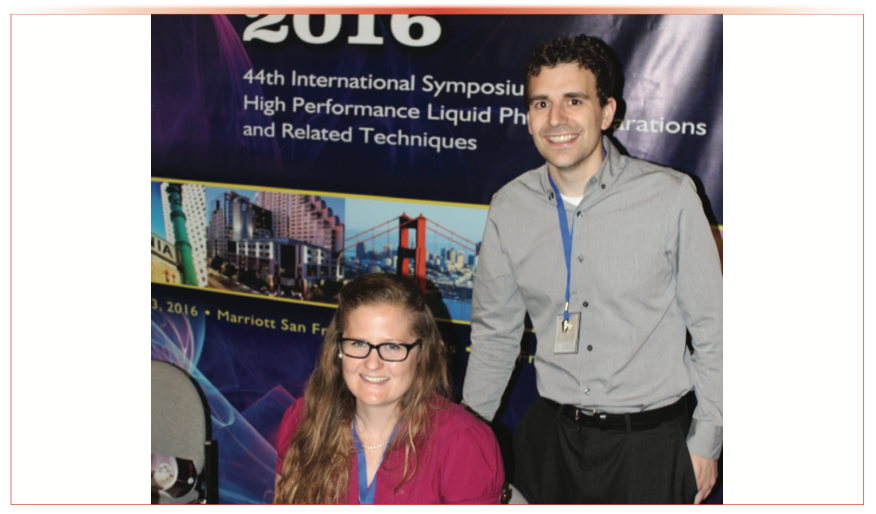
Jim Edwards is a professor of chemistry at Saint Louis University and started collaborating with Grinias on an SFC project about four years ago. This project involves advancement of chromatography for the masses. For this project, Grinias has published an open source, 3D-printing model to provide a clear path for researchers to enter new application areas.
Milton Lee is an Emeritus Professor at Brigham Young University and the Chief Science Officer of Axcend, LLC, in Provo, Utah. Lee had met Grinias several times at conferences when he was a graduate student at UNC; in 2016, Lee and Grinias began talking about working together. After Grinias became a faculty member at Rowan University, he and Lee began to put together a series of collaborative small business–university research proposals jointly between Axcend and Rowan University for submission to the National Institute of Health (NIH), which were awarded funding starting in 2019. “This was the beginning of a productive and enjoyable research collaboration, which continues today,” Lee said. “Grinias’s research focus and major contributions have been in understanding and improving the performance and robustness of capillary LC, and facilitating the adoption and practice of open science principles in chromatographic research and practice,” he said. Lee noted that Grinias continues to make significant contributions to simplifying instrumentation, methods, and software, and in improving robustness without sacrificing chromatographic performance. “I expect that Jim will also make an extraordinary impact in the training of students in the field of chromatography as time passes,” Lee said.
Stephen Weber, Steve Groskreutz, Gert Desmet, Fabrice Gritti, and James Grinias celebrated Desmet receiving the prestigious American Chemical Society Award for Chromatography in April 2019 at the ACS National Meeting in Orlando, United States.
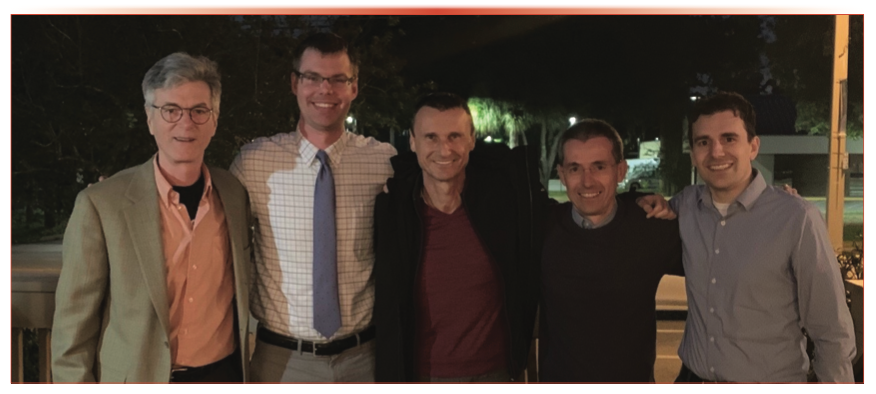
Ron Majors is an LCGC emeritus columnist and now retired from industrial research. He remembers Grinias’s lecture at the HPLC 2013 conference, where Grinias won the Csaba Horvath Award for the best presentation by a student. “I knew then that he was destined for a great future in separation science,” Majors said. “In his short career, Jim has accomplished a lot.” Majors pointed out that Grinias and his students have miniaturized analytical separation instruments to provide a better understanding of band broadening in extremely low-volume systems, and have explored parameters related to sample injection and connection hardware. He also pointed out that Grinias has provided several methods of optimization that have been incorporated into commercial instrumentation and has studied packed beds in capillary and glass-chip microfluidic devices with regard to frictional heating.
Heather Holmes is a professor of chemistry at Eastern Michigan University and has known Grinias since he applied for the Presidential Scholarship at Eastern Michigan University in 2005. Approximately 80 candidates were invited to an in-person interview based on their scores on the scholarship test; the selection committee all agreed that Grinias was at the top of their list of candidates, and would definitely be offered the scholarship. “Jim’s research has definitely made him a prominent figure in chromatography,” she said. “I think that one of the most impactful areas of his work will ultimately be in education.” Holmes notes that as an undergraduate, Grinias was interested in teaching. “Jim is excited to work with students, and really cares about their success,” she said. “It seems inevitable that other stellar chromatographers will have their beginnings in his classes and labs.” She pointed out that in addition to his con- tributions to theory and instrumentation, Grinias has developed low-cost and open-source systems that can be implemented in the classroom.
The Chromatography Forum of the Delaware Valley and distinguished guests Richard Henry, Joe Foley, Mary Ellen McNally, Ronald Majors, Carol Majors, David Kohler, William Barber, Matthew Klee, Peter Schoenmakers, Mary Wirth, James Grinias, and Kaitlin Grinias (left to right) celebrated Majors’ receiving the Dal Nogare award, for his contributions to the fundamental understanding of the chromatographic process, in March 2020 for Pittcon in Chicago, United States. Pittcon 2020 was the last major in-person international gathering of chromatographers.
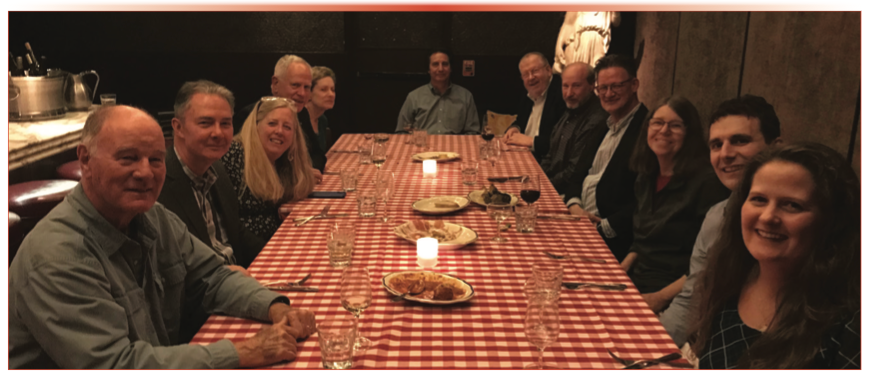
Teacher and Learner
“While Jim was in my lab, he was a master teacher and highly influential on my students,” Kennedy said. Grinias was so helpful to students that he ended up being a co-author on two papers that were not in his original research project. Besides his research contributions, Grinias continues to advance technology and development for education, including low-cost instruments, open-source textbooks and software, and augmented reality programs. With all of Grinias’s activities, “he is becoming an important community citizen,” Kennedy said.
“As Jim’s colleague and wife, I have the unique delight of living with a walking search engine for chromatography references, a troubleshooting guru, a publication editor, and a coruscating exemplar of pushing the boundaries of chromatography,” Kaitlin Grinias said. She also remembers his determination from the beginning when they both studied at UNC. “Packing a capillary column was a rite of passage for joining the Jorgenson group,” she said. “Jim’s perseverance to learn the art of column packing directly led to his first publication in a high-impact journal.”
James Jorgenson, who was Grinias’s PhD advisor, is now a Professor Emeritus at the University of North Carolina at Chapel Hill.
“Jim’s PhD research in my group was very broadly based,” he said. “This was the result of his insatiable curiosity concerning the research of all the other students in the group.” Jorgenson said Grinias was constantly discussing other students’ research problems and helping them with their work. “It was clear early on that Jim was a natural-born professor,” he said. “The other thing I find very special about Jim is his generosity—he is always ready and eager to volunteer to help those less fortunate than him.”
An Influencer into the Future
“Jim’s been nicknamed the ‘Mayor of Pittcon’ because he seems to know everyone,” Edwards said. “I mean everyone. I’ve never been in public with Jim where someone hasn’t come up to say ‘hi,’ ask a question, or shake hands with him.” Edwards noted that Grinias’s combination of wide knowledge of separations and friendly nature makes him a great collaborator and friend. “If you ever get a chance to spend time with Jim,” he said, “you’ll end up learning a lot and laughing ‘til your stomach hurts.”
“Jim has a very engaging personality; he is always happy and enthusiastic about his research,” Lee said, adding that Grinias is also enthusiastic about his teaching assignments, students, colleagues (local and around the world), and, especially, his growing family. “His enthusiasm is exceptionally contagious,” he said.
Majors says that Grinias has been especially good at getting overseas contributors, who ordinarily would never have been able to visit, to present live presentations for CFDV, even during the Covid-19 restrictions. “Jim is also a great communicator, has a congenial personality, and makes everyone feel that they are needed,” he said.
Heather Holmes tells a story about transferring wisdom to Grinias. Many years ago she shared something with Grinias that her doctoral advisor, Richard Sacks, had told her:
“When you get your office (at your first academic job), close the door, put your feet on the desk, and look around. Enjoy it because you’ll be too busy with teaching and research to relax like that again.” Soon after Grinias began at Rowan, Holmes got a text from Jim with a picture of his feet on his desk in his new office. “I still laugh that he remembered that conversation from so long ago,” she said. “But even better, it’s pretty clear that he has the energy to have multiple projects going in addition to teaching, and I’m quite sure that he still finds time to relax (maybe even with his feet up on his desk).”
References
(16) J. De Vos, D. Stoll, S. Buckenmaier, S. Eeltink, and J.P. Grinias, Anal. Sci. Adv. 2(3–4), 171–192 (2021).
(17) J.J. Davis, M. Padalino, A.S. Kaplitz, G. Murray, S.W. Foster, J. Maturano, and J.P. Grinias, Anal. Chim. Acta 1151, 338230 (2021).
(18) J.P. Grinias and E.G. Franklin, Chromatography Today 14(1), 34–38 (2021). https://www. chromatographytoday.com/article/liquid- chromatography/65/regis-technologies-inc/considerations-for-sample-injection-in-high-throughput-liquid-chromatogra- phy/2902
(19) A.S. Kaplitz, M.E. Mostafa, S.A. Calvez, J.L. Edwards, and J.P. Grinias, J. Sep. Sci. 44(1), 426–437 (2021).
(20) J.A. Naese, D. McAteer, K.D. Hughes, C. Kelbon, A. Mugweru, and J.P. Grinias, J. Chem. Educ. 96(3), 593–596 (2019).
(21) J.P. Grinias, B. Bunner, M. Gilar, and J.W. Jorgenson, Chromatography 2(4), 669–690 (2015).
(22) S.W. Foster, X. Xie, M. Pham, P.A. Peaden, L.M. Patil, L.T. Tolley, et al., J. Sep. Sci. 43(9–10), 1623–1627 (2020).
Jerome Workman, Jr. is the Senior Technical Editor for LCGC North America and Spectroscopy. Direct correspondence about this article to: jworkman@mjhlifesciences.com.
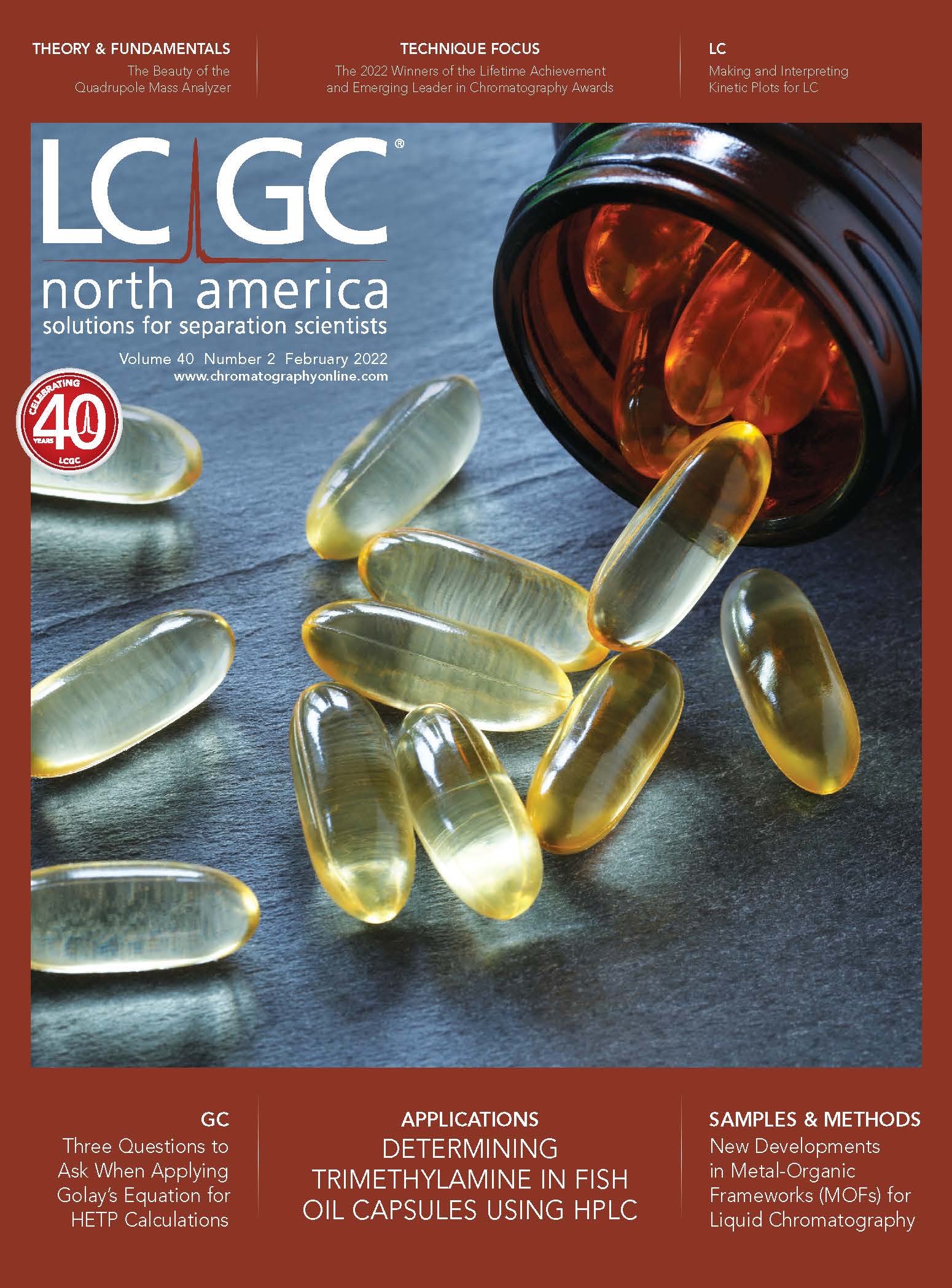
Investigating 3D-Printable Stationary Phases in Liquid Chromatography
May 7th 20253D printing technology has potential in chromatography, but a major challenge is developing materials with both high porosity and robust mechanical properties. Recently, scientists compared the separation performances of eight different 3D printable stationary phases.
Characterizing Polyamides Using Reversed-Phase Liquid Chromatography
May 5th 2025Polyamides can be difficult to characterize, despite their use in various aspects of everyday life. Vrije Universiteit Amsterdam researchers hoped to address this using a reversed-phase liquid chromatography (RPLC)-based approach.

.png&w=3840&q=75)

.png&w=3840&q=75)



.png&w=3840&q=75)



.png&w=3840&q=75)












